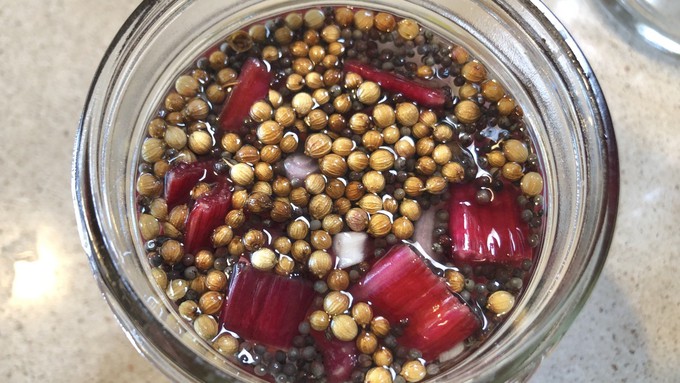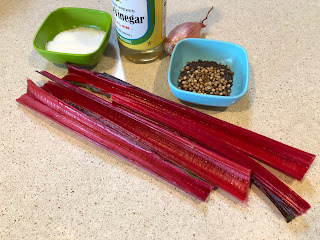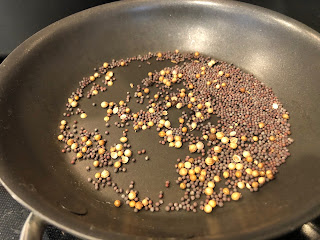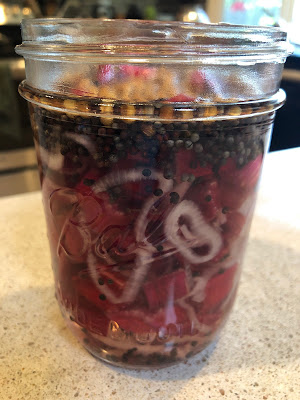
Recipe: Rainbow chard stalks produce a pretty snack

Red chard stems and spices are covered in brine, ready to chill in the refrigerator. Kathy Morrison
In my continued quest to not let anything go to waste these shelter-at-home days, I went hunting for recipes to use chard stalks. There had to be something out there that used the long, pretty, celery-like stems from my never-say-die chard plant .
I hit on pickles, and have tried a couple of recipes now. The one here (adapted from an Epicurious recipe) is my favorite so far, with mustard seeds, coriander seeds and a shallot -- adding a lot of flavor to the gorgeous but rather bland chard stalk pieces.
These pickles aren't as fast as our blog's famous Zapped Pickles , but they still go together pretty quickly. No canning is involved, since they pop into the refrigerator, but make sure to have a sterilized pint jar ready to put them in. (The dishwasher works just fine.) Then chill and enjoy!
Refrigerator chard stem pickles
 |
|
A few ingredients are all you need to make a pint of pickles.
|
Makes 1 pint
Ingredients:
4 large stalks from chard, washed and trimmed
1 small shallot, thinly sliced
2 tablespoons kosher salt
1 tablespoon brown mustard seeds
1/2 tablespoon coriander seeds or caraway seeds
A couple of black peppercorns, optional
Brine:
1/2 cup unseasoned rice vinegar (champagne vinegar, apple cider vinegar or white wine vinegar also work, but avoid distilled white vinegar)
1/4 cup granulated sugar
1/2 cup water
Instructions :
 |
| Toast the seeds before using in the pickles. |
Slice the chard stems into 1/2-inch pieces, removing any outer strings that come loose as you cut. You should have about 2 cups of pieces. Combine the chard pieces with the shallot slices and the salt in a colander set in the sink or over a large bowl. Let stand 1 hour.
About 15 minutes before the chard stems are ready, toast the mustard seeds and coriander seeds (and peppercorns, if using) in a small, dry skillet over medium heat. Stir often. In about 2 minutes, the mustard seeds will start to pop open. Remove the pan from the heat before too many pop, and let the seeds cool.
To make the brine, combine the vinegar, sugar and water in a small saucepan, and bring to a boil. The sugar should dissolve quickly. Remove pan from heat.
 |
|
After cooling the brine-covered pickles for a few minutes,
cover them and refrigerate overnight.
|
Rinse the chard stems/shallot combination well, and drain well. Pack the stems, shallots and cooled seeds in a sterilized (washed in hot soapy water or in dishwasher) pint jar. Pour the brine into the jar over the vegetables. Let the mixture cool slightly, then cover the jar with a tight-fitting lid and place it in refrigerator. Chill overnight before serving. Gently shake the jar occasionally, if you think of it, but that's not a must.
The pickles will keep in the refrigerator about a month. If you used red chard stems, the lovely color will fade eventually, but the pickles likely will be consumed before that happens.
Comments
0 comments have been posted.Sacramento Digs Gardening to your inbox.
Food in My Back Yard Series
April 29: What's (already) wrong with my tomato plants?
April 22: Should you stock up on fertilizer? (Yes!)
April 15: Grow culinary herbs in containers
April 8: When to plant summer vegetables
April 1: Don't be fooled by these garden myths
March 25: Fertilizer tips: How to 'feed' your vegetables for healthy growth
March 18: Time to give vegetable seedlings some more space
March 11: Ways to win the fight against weeds
March 4: Potatoes from the garden
Feb. 25: Plant a fruit tree now -- for later
Feb. 18: How to squeeze more food into less space
Feb. 11: When to plant? Consider staggering your transplants
Feb. 4: Starting in seed starting
Sites We Like
Garden Checklist for week of May 4
Enjoy this spring weather – and get gardening!
* Plant, plant, plant! It’s prime planting season in the Sacramento area. Time to set out those tomato transplants along with peppers and eggplants. Pinch off any flowers on new transplants to make them concentrate on establishing roots instead of setting premature fruit.
* Direct-seed melons, cucumbers, summer squash, corn, radishes, pumpkins and annual herbs such as basil.
* Harvest cabbage, lettuce, peas and green onions.
* In the flower garden, direct-seed sunflowers, cosmos, salvia, zinnias, marigolds, celosia and asters. (You also can transplant seedlings for many of the same flowers.)
* Plant dahlia tubers. Other perennials to set out include verbena, coreopsis, coneflower and astilbe.
* Transplant petunias, marigolds and perennial flowers such as astilbe, columbine, coneflowers, coreopsis, dahlias, rudbeckia and verbena.
* Keep an eye out for slugs, snails, earwigs and aphids that want to dine on tender new growth.
* Feed summer bloomers with a balanced fertilizer.
* For continued bloom, cut off spent flowers on roses as well as other flowering plants.
* Add mulch to the garden to maintain moisture. Mulch also cuts down on weeds. But don’t let it mound around the stems or trunks of trees or shrubs. Leave about a 6-inch to 1-foot circle to avoid crown rot or other problems.